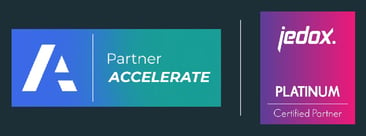More and more businesses are finding that Anaplan’s Connected Planning platform has become indispensable for impactful decision-making. Forrester's Total Economic Impact study found ROI to be in excess of 300% for Anaplan Implementations in just 3 years.
Anaplan is a very flexible platform that can be configured to meet your exact business planning requirements across all business functions. As with any flexible business tool, best practice is important to make your implementation a success and to deliver maximum business value and ROI.
Read on to discover Anaplan best practices and why they're critical to success.
- The top ten best practices for Anaplan
- Why are practices like these important?
- How do Anaplan partners utilise best practices?
THE TOP TEN BEST PRACTICES FOR ANAPLAN
1. Ensure all users are on-board at the outset…
User adoption tends to be a struggle if users are not involved from the very beginning. Business users will adapt to new ways of working throughout the entire project and that's why they need to be fully involved at the outset. It is important that they feel consulted, and that their views are taken into account, for the solution to be accepted and become fully embedded in the business.
2. ...And don’t forget to train them.
When implementing Anaplan, training is crucial.
Unlike many other technology projects, where training takes place after the solution is delivered, training should be undertaken before a project begins. This is so your team has a good basic foundation when they begin to use the platform.
Fortunately, Anaplan has a wide range of courses that capture all aspects of the technology’s functionality. These courses will help you develop that key ‘Anaplan thinking’.
Whether you’re a Solution Designer or Model Builder, sufficient training helps you understand the Anaplan environment, why it’s needed, what it delivers and how it works. This gives your team a clear view of what's possible in Anaplan so that they know what to ask for, are inspired and can contribute effectively.
3. Think futureproof.
The Anaplan platform is extremely flexible and easy to change to meet the future needs of your organisation. As you begin to model one process, you need to consider all the models that you plan to build so that all dependencies and links between processes are identified.
4. High-level design.
Spending time thinking about the requirements of Connected Planning and how to capture them within the Anaplan ecosystem is very important.
This time allows you to plan, model, and spot any possible obstacles before you actually start building. Moreover, a well maintained and updated model map helps any new people understand the entire data flow.
The agile approach that we employ for Anaplan projects doesn't mean that you can go straight into the model build phase without a view of what the final solution is going to look like. After all, would you build a car if you didn't know how it was going to look?
5. Use Anaplan knowledge base.
Anaplan offers its own source of knowledge, including Anapedia and Anaplan community, both of which are great sources for problem-solving and clever design tips.
6. Use easily identifiable signifiers for actions.
Anaplan is made up of actions and processes. This means without sufficient names, things can get lost in this fast-paced data environment.
Input, export, mapping, staging - each of these module types serves an important purpose, so they need to be easily identifiable. Why not try a combination of numbers, letters and locations to act as the name for each action?
7. Create ordered lists to increase efficiency.
Anaplan thrives in a logical, well-ordered environment. When we create planning models, lists and actions need to be ordered effectively. Not only does this save time but it also allows you to be more intuitive when you navigate your model.
8. Utilise the organisational functions of Anaplan.
Utilise functional areas to group both dashboards and modules separately. This allows for incredibly quick access to dashboards and makes assigning user access very simple. You can also use the navigation panel to see each path, which users can use to explore where they are in each process.
9. Project management.
The Anaplan App Hub allows you to download project management applications called Agile Implementation. These help you to track all project requirements (user stories), timeline and resources.
10. Test Management
To ensure a successful go-live, you need an effective testing process. Appoint a Test Manager during the foundational phase of the Anaplan implementation. This role is client-side and helps to create a more rational testing programme. A Test Manager also helps to ensure that the resources for UAT are fully secured.
These best practices are an essential part of the success of any planning model. Let’s explore why they’re so important for getting the most out of a Connected Planning process.
WHY ARE PRACTICES LIKE THESE IMPORTANT?
The Anaplan platform enables multiple, flexible, and secure planning models to be tailored to your exact planning and MI needs. Not only this, but this powerful connected planning platform connects planning processes to drive effective collaboration between business units for effective decision-making. However, this comes with a degree of complexity that needs to be managed.
In addition, the rapid development of Anaplan models, through the Anaplan Agile methodology, means that it's essential to follow best practices. And all too often this comes down to experience.
Without these unique and useful practices, the rich data ecosystem Anaplan offers can be made inefficient and confusing. The best way to implement these kinds of best practices is through experience. That’s where an Anaplan partner comes in.
HOW DO ANAPLAN PARTNERS UTILISE BEST PRACTICES?
While these practices can be done on an individual level, you know that your project is on safe ground when working with an Anaplan partner. Partners have a long and intuitive experience of delivering the Anaplan ecosystem across a wide range of use cases, creating enhanced planning models in multiple industries.
They are the ones who know these Anaplan best practices intimately, as well as others we haven’t included.
Now, this list of best practices isn’t exhaustive - but it’s a good starting point for Anaplan users. However, by using this intuitive planning platform, there are multiple practices that can be discovered and employed in a variety of situations. If you want to discover more about how Anaplan works in practice, explore our case studies.
DISCOVER MORE BEST PRACTICES WITH OUR PROCESS INFOGRAPHIC
Our Profit& Process infographic will take you through the whole process of how we implement an iterative, functional and value-based Anaplan set-up for your specific business needs.
For more insight into how we create an innovative planning system for you, just click the link below to get started.





